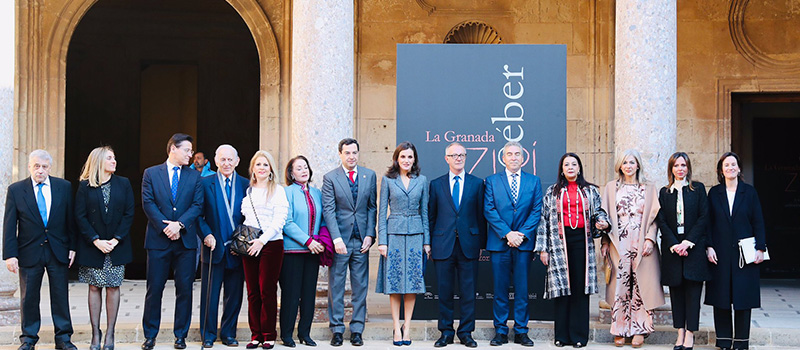The exhibition has been organized by the Board of the Alhambra and the Generalife and El legado andalusí Foundation with the collaboration of the Foundation Doctor Leila Mezian, from Morocco.
Her Majesty the Queen Doña Letizia arrived at the Palace of Charles V in the Alhambra, where the exhibition is housed, accompanied by the President of the Andalusian Government, Juanma Moreno, the Minister of Culture and Sports José Guirao and the Delegate of the Government of Andalusia, Lucrecio Fernandez. The Queen welcomed other authorities in the courtyard of the Renaissance palace, such as the Regional Minister of Culture, Patricia del Pozo and the directors of the organizing entities: Rocío Díaz, director of the Board of the Alhambra and the Generalife, and Concha de Santa Ana, director of El legado andalusí Foundation, Doctor Leila Mezian, Luis Salvador, mayor of Granada and the exhibition curator Antonio Malpica.
This exhibition aims to showcase the culture of the Berbers, an amalgam of peoples that have inhabited Northern Africa since ancient times. The Berbers constitute a group of peoples that settled in a wide geographical area that stretches from western Egypt to the Atlantic side of the African continent, including the Canary Islands.
Witnesses to the history of the Mediterranean world, their identity has been enriched by the different cultural contributions throughout time, although it has crystallized mainly thanks to their language, the Amazigh (which has different varieties), customs, festivals and traditions of a community that assumes a common legacy of their own.
The collection coming from the Foundation Doctor Leila Mezian illustrates through relevant pieces the cultural entity of this human group by means of an anthropological testimony which ranges from the rural world (peasants and cattle breeders) to the urban world. The Chapel and Crypt of the Palace of Charles V are the spaces where representative elements belonging to the Berber culture give voice to a civilization with a strong cultural personality.
Looking into their rich past, it should be noted that it was precisely a Berber dynasty, the Zirids, who made of Granada the capital city of an independent political entity in the 11th century: the taifa kingdom of Granada. We owe to that period a rich monumental heritage, such as El Bañuelo Arab baths, or the minaret of the mosque, later converted into the tower of the Church of San José, among others. Centuries later, this dynasty was followed by other equally important groups for the reunification of Islam in the West: the Almoravids and the Almohads (11th century), and the Marinids (13th century), whose emirate established in Fez maintained a strong link with the Nasrid dynasty.
The exhibition is open to the public from December 5, 2019 to April 21, 2020 and is housed in the Chapel and Crypt of the Palace of Charles V.


